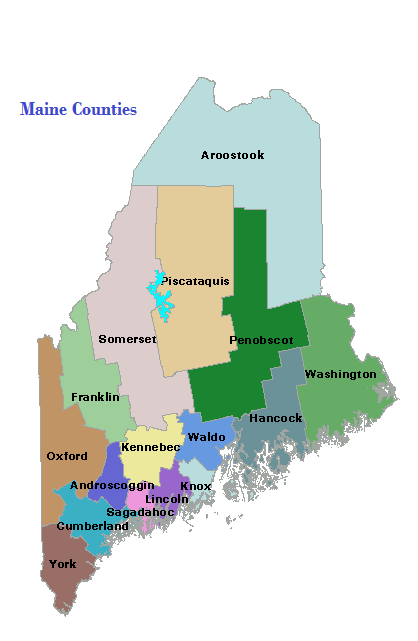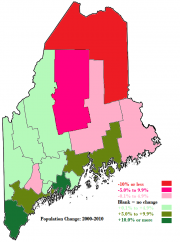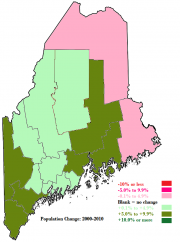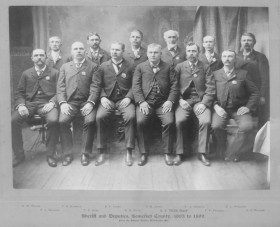 Maine has sixteen counties, as well as hundreds of local governments. The earliest established was York, in 1652; the latest, Knox in 1860. The structure and functions of county government are similar throughout the state. For a brief sketch of each county, click on its name in the map at right.
Maine has sixteen counties, as well as hundreds of local governments. The earliest established was York, in 1652; the latest, Knox in 1860. The structure and functions of county government are similar throughout the state. For a brief sketch of each county, click on its name in the map at right.
Aroostook is the largest by area, while Sagadahoc is the smallest. Cumberland is the most populous; Piscataquis has the fewest people.
Based on the 2000 U.S. Census, northern Maine, especially Aroostook and Piscataquis counties, already sparsely inhabited, continued to lose population. The coastal counties, except for Washington, made substantial gains, while the inland “middle” counties maintained about the same population they had a decade earlier.
The 2010 Census again showed population loss in the eastern most counties of Aroostook and Washington, while the western counties of Oxford, York, and Cumberland posted substantial gains.
Coastal counties, except for Washington, continued to add population, while inland “middle” counties posted more modest advances, with the exception of the faster growing Penobscot County.
Androscoggin, the Native American term for “the place for preparing or curing fish,” became the name for the county through which the Androscoggin River flows.
Aroostook (Micmac for shallow or beautiful river) County almost had its own private war when a border dispute between the county and Canada escalated in 1838; it is the largest county with a greater land area than Connecticut and Rhode Island combined.
Cumberland was named for a county in England. Benjamin Franklin was honored by selecting his name for Franklin County. John Hancock, first governor of Massachusetts, is the inspiration for Hancock County’s name.
Kennebec County got its name from the river whose title comes from the Abenaki for “long reach” or “long level water.” Knox was named after Henry Knox, first U.S. Secretary of State. Lincoln’s name derived from Thomas Pownal, an early governor of Massachusetts, whose home was Lincoln, England.
Piscataquis translated from Algonquin means “rapid waters.” Oxford County was named for the town of Oxford, Massachusetts. Penobscot is the Native American term for “rocky part of the river,” which describes a portion of that river in Penobscot County.
Sagadahoc, the Native American name for the mouth of the Kennebec River, is the county through which that River flows to the sea. England’s Somerset County, home to Sir Fernando Gorges, holder of several early land grants in Maine, lent its name to the county of the same name in Maine.
Washington was named for President George Washington; Waldo, for general Samuel Waldo, the “prime commercial agent” for pine masts; York, for York, England.
According to Kenneth Palmer,
County government came to New England as part of the English tradition in the British shire model. . . The Maine legislature of 1820 maintained the county system it inherited from Massachusetts, and most officials were appointed by the governor and [the governor’s] council.
In 1855 the appointive county officers became elective. . . . The duties of county officials have remained largely administrative and narrowly defined because the county is a subunit of the state that operates under state laws.
County government is basically uniform among all sixteen entities. Usually three county commissioners, sometimes with an administrative assistant, manage the county’s general affairs, including preparation of the budget.
However, the commissioners have little direct control over the departments with elected heads: the Sheriff, Register of Deeds, Register of Probate, Judge of Probate, and Treasurer.
County budgets are generally approved by the State Legislature before local property taxes may be raised to support their programs.
Efforts at “reforming” county government have ranged from abolishing them altogether, giving them home rule through locally adopted charters, to encouraging them to act as regional governments in certain areas. Counties are creatures of the state, receiving all their powers through the state legislature. Abolition would involved changes to the Maine Constitution since it contains several references to counties. (See a brief selection of related publications below.)
In 2010 voters in Cumberland County approved a charter that expands the number of commissioners to five, and allows for more “home rule” authority.
In urban areas support for county government is less than in rural portions of the state, where the Sheriff’s Department law enforcement role is most important and cost-effective.
County Sheriff Departments were the major law enforcement agencies in Maine, except for a few cities, until the mid-twentieth century. By then many towns had their own police departments, and the State Police assumed control of murder investigations.
Still a factor in rural areas, the Departments’ functions have been increasingly focused on operating county jails and serving civil process (requiring appearance in court, payment of debts, etc.).
Additional resources
Counties, Cities, Towns and Plantations of Maine. Maine State Archives. Augusta, Me. circa 1981.
Maine. Legislature. Joint Select Committee on County Government. Report of the Joint Select Committee on County Government: study on county government, H.P.1670. Augusta, Me. The Committee. 1976.
Maine. Legislature. Subcommittee on Redistribution of County Functions. County Government: a study of its structure & possible redistribution of certain functions: final report of the Study Subcommittee [to the ] Joint Standing Committee on State & Local Government. Augusta, Me. [The Committee?], 1989.
Maine County Commissioners: laws and general information relating to powers and duties of the early office and the Court of Sessions which preceded it. [Compiled by the staff of the Maine State Law and Legislative Reference Library] Augusta, Me. The Library. 1974.
McKinney, William J. County Government in Maine — 1966. Waterville, Me. Colby College. 1966.
Nichols, David Arthur. A Study of County Government in Maine. Lewiston, Me. Bates College, Department of History and Government. 1942.
Palmer, Kenneth T. (et al.) Maine Politics and Government. Lincoln, NB. University of Nebraska Press. c2009.




